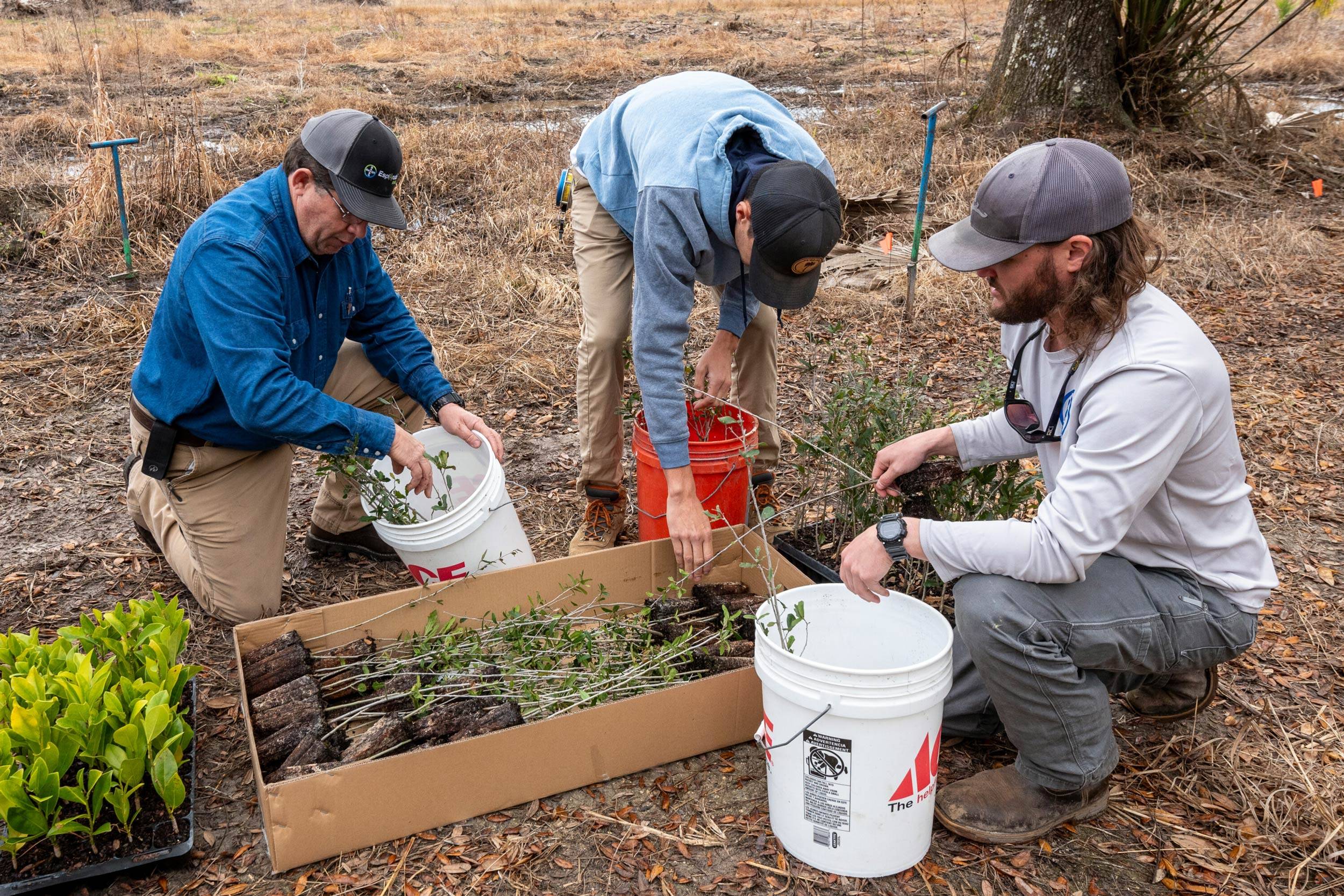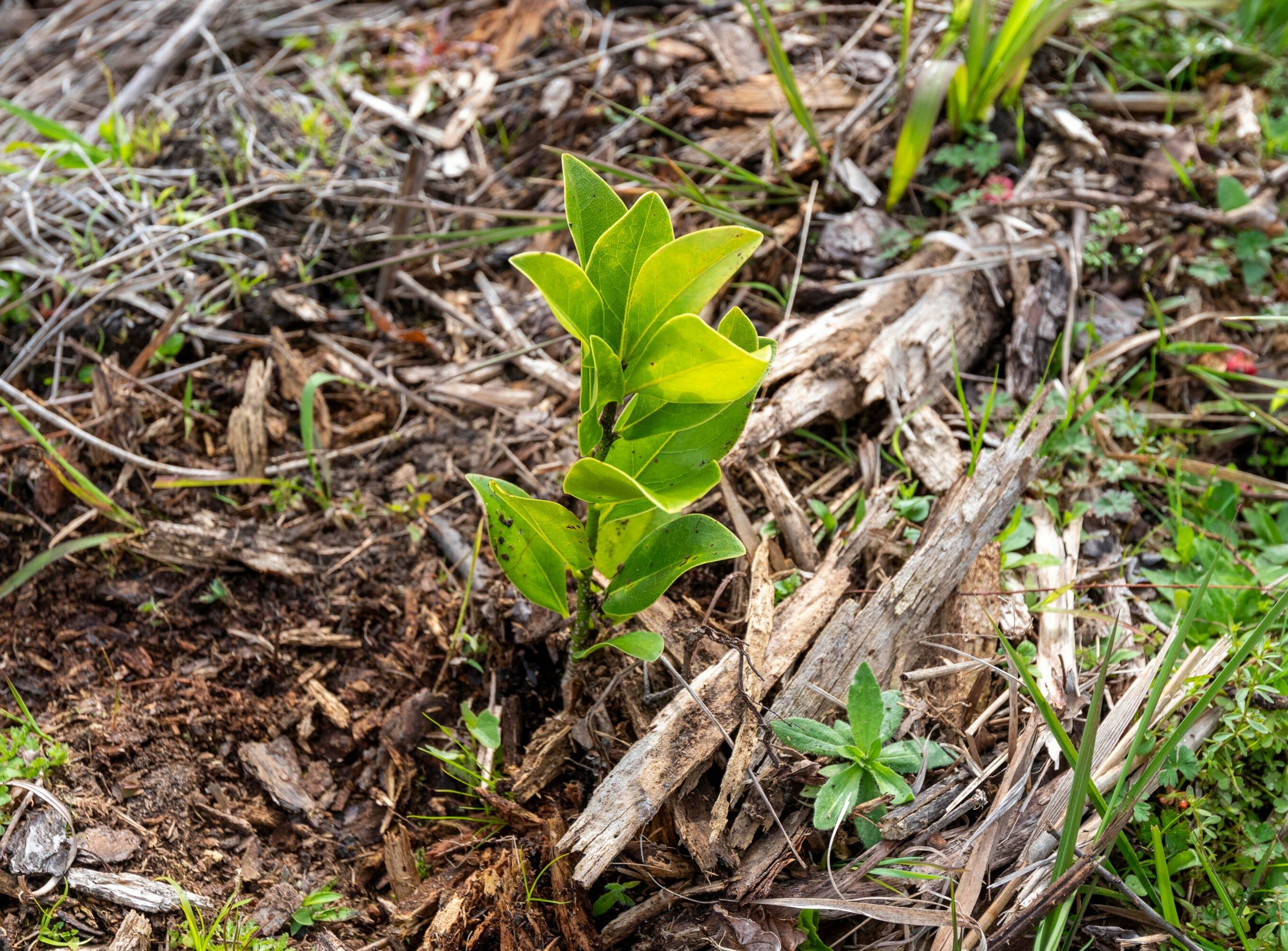Hardwood planting helps restore natural systems at Silver Springs Forest Conservation Area
March 28, 2024
District Land Manager Paul Hudson (left) and Land Resource Specialists Ali Simpson and Kyle Madden (right) put hardwood seedlings in 5-gallon buckets to hold while planting.
Long ago, before highways, homes and businesses spanned across the state, the Silver Springs Forest Conservation Area was dominated by a mesic hardwood forest with oak trees spanning thousands of acres. Fast forward to today, and that same forest is now predominantly covered by pine trees.
The forest’s landscape, once abundant with hardwood species, changed many years ago. Most of the hardwoods were removed, and the area was converted to pine plantations. More recently, the area was privately managed for timber production.
Large hardwood forests were historically uncommon in this part of Florida, where lightning-ignited natural fires routinely swept the state. It takes a unique combination of hydrology, soils and protection from fire for hardwood forests to thrive, often only occurring in pockets near water bodies that are sheltered from fire. The Silver Springs Forest has such a pocket, with creeks and tributaries on the east and west that flow into the Silver River on the south, providing an ideal environment for hardwood forest development.
In 2015, the St. Johns River Water Management District purchased the property to provide water resource protection to the Silver and Ocklawaha rivers, the Silver Springs springshed and more than 1,000 acres of diverse wetlands. The forest’s conversion from hardwood to pine had resulted in adverse effects, including sediment runoff and increased nutrients entering the nearby water bodies. After the District’s acquisition of the property, the Bureau of Land Resources developed a land management plan that included a strategy for restoring 600 acres of Silver Springs Forest to a mesic hammock by 2032. A mesic habitat is one that has moderate, or well-balanced, moisture during its growing season.
“District lands are critical to addressing all of our core missions, especially natural systems,” explains Brent Bachelder, a land resource specialist at the District who has worked on multiple restoration and planning projects. “Typically, hardwood forests require less management than pine. In the long run, the objective of restoring this area to its natural habitat is to reduce sediment and nutrient runoff into the surrounding waterways, improving water quality. It will be a healthy, functioning natural system.”
District lands are critical to addressing all of our core missions, especially natural systems.
While the District is no stranger to bringing habitats back to their natural state, this would be the first time that a hardwood forest would be restored from pine. With little published material on this type of restoration available, land managers knew it was critical to perform the initial phases of the restoration incrementally, experimentally and using the principles of adaptive management, an approach allowing for adjustments to decision-making as new information is gathered and put into context.
“We started small, with a 31-acre site,” says Paul Hudson, one of the District’s land managers who specializes in forestry. “Our goal was to use it as a learning tool. We’ll have multiple plantings over the next few years, and this was a method to gauge how to plan for future phases.”
The project faced some challenges. The forest’s clay soil meant the heavy equipment they needed to prepare the site could only be brought in when the ground was dry. There was a shortage of loggers and tree planting contractors to work with. It was even difficult to find nurseries with hardwood seedlings. Fortunately, everything came together. The pine trees were harvested, the site was prepped and the District worked with a contractor to plant 17,000 live oaks, laurel oaks, water oaks, swamp chestnut oaks and southern magnolias throughout the 31-acre site.
“We learned that planting oak seedlings is much slower than planting pines,” Hudson explains. “Their root mass is greater, and you have to be careful with them; really finesse the roots into the hole.”
The contractor’s team of 10 people needed two full days to plant all 17,000 trees. Land Resources staff finished the project by planting an additional 400 trees to complete the site. Now that the hardwood seedlings are in the ground, they should grow about 2 feet a year and eventually form a closed canopy, providing forage for animals like deer and turkey and a space for the public to enjoy.
“Restoration does take time, but these trees are meant to be here, so they should grow well,” Bachelder says. “In about 50 years, when you and your children visit Silver Springs Forest Conservation Area, you should see a beautiful mature oak canopy.”
For more information about this property, visit www.sjrwmd.com/lands/recreation/silver-springs.





